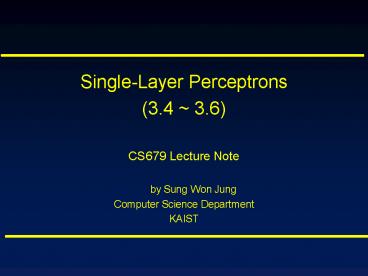Single-Layer Perceptrons - PowerPoint PPT Presentation
1 / 11
Title:
Single-Layer Perceptrons
Description:
Single-Layer Perceptrons (3.4 ~ 3.6) CS679 Lecture Note by Sung Won Jung Computer Science Department KAIST Linear Least-Squares Filter The single neuron around which ... – PowerPoint PPT presentation
Number of Views:146
Avg rating:3.0/5.0
Title: Single-Layer Perceptrons
1
- Single-Layer Perceptrons
- (3.4 3.6)
- CS679 Lecture Note
- by Sung Won Jung
- Computer Science Department
- KAIST
2
Linear Least-Squares Filter
- The single neuron around which it is built is
linear - The cost function consists of the sum of error
squares - Using and
the error vector is - Differentiating with respect to
- correspondingly,
- From Gauss-Newton method, (eq. 3.22)
3
Wiener Filter (for Ergodic Env.)
- Correlation matrix of
- Cross-correlation vector between ,
- Wiener solution to the linear optimum filtering
problem - For an ergodic process, the linear least-squares
filter asymptotically approaches the Wiener filter
4
LMS Algorithm (I)
- Based on the use of instantaneous values for cost
function - Differentiating with respect to ,
- The error signal in LMS algorithm
- hence,
-
so,
5
LMS Algorithm (II)
- Using as an estimate for the gradient
vector, - Using this for the gradient vector of steepest
descent method, LMS algorithm as follows -
learning-rate parameter - The inverse of is a measure of the memory
of the LMS algorithm - When is small, the adaptive process progress
slowly, more of the past data are remembered and
more accurate filtering action
6
LMS Characteristics
- LMS algorithm produces an estimate of the weight
vector - Sacrifice a distinctive feature
- Steepest descent algorithm follows a
well-defined trajectory - LMS algorithm follows a random
trajectory - Number of iterations goes infinity,
performs a random walk about Wiener solution - But importantly, LMS algorithm does not require
knowledge of the statistics of the environment
7
LMS Summary
Training Sample Input signal vector
Desired response
User-selected parameter Initialization.
Set Computation. For n 1, 2, , compute
8
Convergence Consideration
- Two distinct quantities, and
determine the transmittance of feedback loop - With environment that supplies , the
selection of is important for the LMS
algorithm to be converge - Convergence of the mean
- as
- This is not a practical value
- Convergence in the mean square
- Convergence condition for LMS algorithm in the
mean square
9
Virtue and Limitations
Virtue
Limitations
- Simple
- Model independent, so
- robust
- Satisfactory in stationary
- and nonstationary
- environment
- Slow rate of convergence
- Sensitivity to variations in
- the eigenstructure of the
- input
Condition number
is high, then training sample is illl conditioned
10
Learning Curves (I)
- Plot of the mean-square value of the estimation
error , versus the number of iterations - Misadjustment
- The smaller M is compared to unity, the more
accurate is the adaptive filtering action - For example, misadjustment of 10 means that the
filter produces mean-square error that is 10
greater than the minimem mean-square error
produced by corresponding Wiener filter - Increasing learning-rate to accelerate learning
process, the misadjustment is increased.
Conversely, similar result.
11
Learning Curves (II)
Number of iterations
Rate of convergence (arbitrary chosen)































